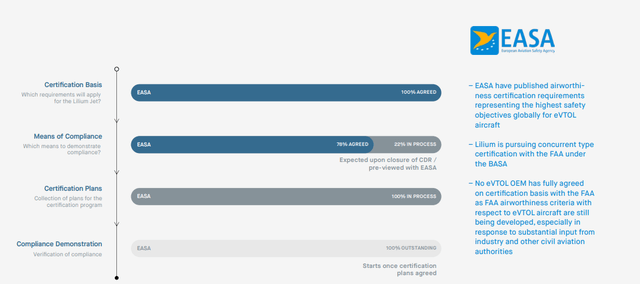I’ve been covering eVTOL manufacturers for some time now and generally while I am charmed by the concept of eVTOL and the disruptive applications, I have significant doubts about the value it can return to shareholders as service-entry windows as well as production ramp up seem to be composed of very rosy projections. In this report, I will be looking at Lilium’s latest update.
The Risks Of Urban Air Mobility
One risk I am seeing with the coverage of UAM or eVTOL names is that disruptive technology is often equated to value creation, while this is not necessarily the case.
In one of my previous reports, one of the article bullet points was the following:
The eVTOL development is in its early phase and it is likely that many of the eVTOL designs won’t enter the market or create sustained success.
That remark will apply for the foreseeable future. In some ways, urban air mobility at the current stage is not much different from biotech or disruptive technology applied in commercializing space. There is a disruptive technology, which needs to be tested thoroughly, and UAM solution providers need to develop their product, test, and then scale up production. With the many UAM players active, there is no doubt that some will not be able to deliver on their prospects and might run out of liquidity runway even before their product is launched.
Putting it extremely simple, the risks regarding eVTOL are concentrated around timelines and liquidity.
The Timeline For Lilium
Lilium
Lilium provided the timeline above for the certification of its eVTOL solution. The agreed status means that approval by the certifying agency, in this case, EASA, has been obtained, while the “In Process” status means that the paperwork or tasks have been submitted and are pending approval. So, Lilium is currently going through the approval phase for Means of Compliance and has that 78% complete, while a certification plan has been submitted, but is pending approval. After that, the compliance demonstration can start. The first conforming prototype will be built this year and fly in the second half of 2024 with certification in late 2025. The timeline challenge in my view mostly centers on the flight test campaign. Most companies seem to be aiming at a one-year campaign. Perhaps I am too pessimistic in that regard, but even the campaigns for commercial airplanes to be certified under an amended type certificate have taken longer than one year to obtain certification. So, I am considering the projections of a one-year path to certification to be extremely optimistic, and that also holds for Lilium.
The Lilium Liquidity
Lilium
In the first quarter, Lilium burned through €62 million in cash, which is in line with its projections and brings its liquidity to €143 million. The company has been working on raising $250 million. $100 million has been raised successfully via Aceville, an affiliate of Tencent, pre-funding 184.2 million warrants exercisable at $1 per share. Furthermore, another $75 million has been committed by Aceville upon Lilium arranging the remaining $75 million externally. With 400 million shares outstanding, the dilution of existing shareholders, of which Aceville is one, is clear, but it is either that or sink with the ship for many eVTOL makers as the current interest rate environment and banking turmoil does not quite favor loaning at attractive terms for higher risk businesses such as eVTOL makers.
Either way, when the funding is successful, Lilium will have a pro forma liquidity of €375 million. At a burn rate of €60 million, Lilium is fully funded for 2023 and into the second half of 2024 when its first conforming prototype will fly. According to the company, that will enable pre-delivery payments to take flight. On May 23rd, the company announced an agreement with Air-Dynamic for five Lilium jets, followed by an announcement of a firm up for six Lilium Pioneer Edition Jets from ASL Group. Both agreements provide an unspecified downpayment. Taking a 1% downpayment as a percentage of the list price, which is around $4.5 million, gives roughly $0.5 million in additional liquidity. It’s not huge, but it is something. Overall, Lilium has pretty much derisked the trajectory towards the first flight. The funding needs beyond that in the certification phase and production ramp up remain widely unknown, so I would not rule out the need for another funding round to scale up production and in the case of delays in the certification process also fund the delay. Lilium’s plan closes in the sense that the moment its conforming prototype takes flight, it also expects to generate cash flow from pre-delivery payment. Whether that is enough to fund the needs of the company remains to be seen as the scaling of production is costly and initial productions are significantly loss making for traditional airplanes, and I wouldn’t expect it to be significantly different for eVTOLs. So, even with pre-delivery payments in mind, I would expect another funding round.
Conclusion: Partially Derisked, But More Funding Might Be Needed Into The Next Phase
I am assigning a hold to Lilium stock granted that investors are aware that dilution is the most straightforward thing for capital raises and next to the €250 million fund raise that the company is working on now, a second raise might be required. eVTOL stocks offer potential, but this is a name you should only invest and hold shares in if you are fine with potentially losing your investment or in the longer run make multiples. That is the only reason why I would consider buying the stocks now, the downside is limited while the upside is exponential. Nevertheless, questions regarding viability do remain. Presented as solutions for congestion and as air taxis, the $2 per passenger-kilometer cost is still steep compared to actual taxis. So, while there is the potential for mass transport applications and eVTOLs do solve a problem, its actual cost competitiveness remains a watch item.
Read the full article here












